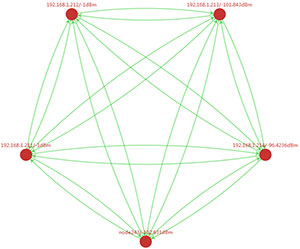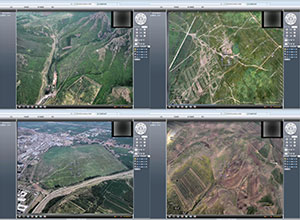I. Market and Development
With the rapid advancement of drone technology, drones are now widely used across various fields such as agriculture, inspection, security, and rescue. Currently, the most common application involves single drones performing tasks. However, this method has limitations: for large-area missions, a single drone may need to make multiple round trips or even relocate several times to cover the entire area, resulting in significant time consumption and relatively low efficiency. Additionally, factors such as terrain constraints often hinder communication between the drone and the ground control station, preventing the drone from reaching certain areas and thus impeding mission execution.
In contrast, drone ad-hoc networks offer several advantages in addressing these challenges:
- Multiple drones can collaborate to perceive the task environment, using ad-hoc networking technology to rapidly share information among themselves, enabling large-scale monitoring of the target area.
- When line-of-sight communication is obstructed, multi-drone relay can achieve seamless coverage without dead zones.
- The drone swarm system does not rely on any single individual. Even if some drones leave or join the swarm, the system maintains its integrity and can continue performing tasks.
II. Concept of Drone Ad-Hoc Networks
A drone ad-hoc network is a dynamic, self-organizing network system composed of drones serving as nodes, characterized by its arbitrary, temporary, and autonomous topology. Each drone is equipped with a mobile ad-hoc network communication module, functioning both as a router and a packet forwarder, enabling the formation of any network topology via wireless connections. In this network, each drone serves dual roles: As a task node, it executes mission objectives under the command of the ground control station or other drones. As a relay node, it participates in routing maintenance and packet forwarding based on the network’s routing policies and tables.
III. Composition of Drone Ad-Hoc Network Systems
A drone ad-hoc network system consists of one ground control station node and multiple drone nodes. As illustrated in Figure 1, one ground control station and four drones form a drone ad-hoc network. Due to limitations in wireless transmission range or terrain, routing between drones may require multiple segments. For example, in Figure 1, Drone C cannot communicate directly with the ground control station but can do so via Drone D (using the route C → D → Ground Control Station) or through Drones A and B (using the route C → A → B → Ground Control Station).

IV. Features of Drone Ad-Hoc Network Solutions
In addition to the general technical characteristics of ad-hoc networks - such as independent networking, self-organization, dynamic topology, unconstrained mobility, and multi-hop routing - drone ad-hoc networks offer the following practical advantages:
Suitable for Complex Terrains and Non-Line-of-Sight Applications
Single drones are often hindered by terrain or other environmental factors, preventing real-time communication with the ground. In a drone ad-hoc network, each drone can act as a relay, enabling operations in complex terrains and non-line-of-sight conditions.
Ideal for Long-Range Coverage
Due to the Earth’s curvature and surrounding terrain, line-of-sight radio transmission is typically limited to less than 50 km. In a drone ad-hoc network, the drone closest to the base station acts not only as a task node but also as a relay. With relay functionality, the communication range can be extended to 150–200 km, reducing the need for frequent往返 (round trips) and relocations, thereby improving mission efficiency.
Strong Anti-Interference Capability
The ad-hoc network transforms the drone swarm from a simple chain structure into a resilient system. Even if any part of the chain fails, the entire system remains operational, significantly enhancing its anti-interference capability.
High Level of Intelligence
Drone ad-hoc networks can promptly detect network changes, automatically configure or reconfigure the network, and ensure real-time data link connectivity, demonstrating high autonomy and adaptability. Moreover, they enable information sharing, processing received data, and making autonomous decisions to intelligently execute tasks.
Diverse Functionality
Once integrated into an ad-hoc network, drones combine their strengths, complement each other, and collaborate divisionally, forming a cohesive whole that achieves better mission outcomes than single drones.
Multi-Channel HD Data Transmission
A single mission can accomplish what would traditionally require multiple tasks. For example, as shown in Figures 2 and 3, in an environmental protection monitoring mission covering a large area, four drones operate simultaneously. The control range between the ground and drones is 50 km, while the maximum control range between drones is 150 km. All four drones can capture FHD video simultaneously and transmit it back to the ground station in real time. If environmental anomalies are detected, multiple drones can be dispatched to the site for multi-angle data collection, avoiding data link failures caused by complex terrain or obstructions like mountains.


V. Industry Applications
Security Industry
Large security perimeters require extensive monitoring. Single drones have limited coverage, necessitating multiple trips or relocations, which is time-consuming and inefficient. Drone failures can also disrupt missions. With drone ad-hoc networks, large-area surveillance can be completed in one go, and multiple drones can monitor issues from different angles. If one drone fails, it does not affect the overall mission.
Emergency Search and Rescue
In mountainous areas, complex terrain and environments can obstruct data links, affecting communication between a single drone and the ground station. Drone ad-hoc networks solve this problem by allowing each drone to act as a relay, ensuring uninterrupted data links.
Geophysical Exploration
Aerial geophysical exploration requires prolonged low-altitude flight for accurate results, but low-altitude operations are limited by the Earth’s curvature, restricting flight radius. Ad-hoc networking addresses this issue by using one or more drones as relays, enabling long-range, low-altitude exploration.
Environmental Protection
In environmental monitoring, drone ad-hoc networks allow flexible scaling of the number of drones based on task requirements. For smaller areas, one or two drones suffice; for larger areas, multiple drones can be deployed efficiently and flexibly to complete the mission.



